Facilities & Instrumentation
Facilities of the Department of Physics, Engineering, and Astronomy at Austin Peay State University include: the Materials Fabrication and Characterization Labs; the APSU Observatory; our complete wood and metal shops, fondly known as the Fantasy Factory; and Loki, our dedicated computer cluster. Detailed descriptions of the facilities and their instruments are below.
3D printing and laser cutting instruments within the Department of Physics, Engineering, & Astronomy include the following:
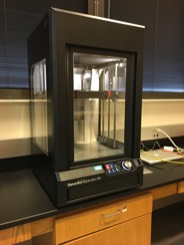 Filament Printers:
Filament Printers:
Prusa i3 MK3S+ 3d Printer
Creality 3D Print Mill Conveyor Belt 3D Printer
Ender 3 V2 3D Printer
FlashForge Creator 3 Pro Independent Dual Extruder 3D Printer
MakerBot Replicator Z18 Fused Deposition Modeler with camera
MakerBot Replicator 2x Experimental 3D Printer
Solidoodle Workbench 3D printers (x2)
Resin Printers:
Elegoo Saturn S Resin Printer
Elegoo Mars3 Resin Printer
Laser Cutter:
Omtech USB570b 80 Watt Laser Cutter
The Robert F. Sears Jr. Planetarium is a 30-seat planetarium housed inside a 16-foot dome. The sky projection system uses a Digitarium Gamma digital projector that can display the sky from anywhere on Earth between 100,000 BCE and 100,000 CE.
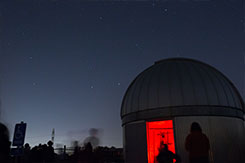 The APSU Observatory consists of a 0.5m Ritchey-Chretian telescope on a German equatorial
mount housed within a 16' dome as well as a storage facility. The telescope is equipped
with a large format imaging camera (Apogee Ulta U16000) with Sloan Digital Sky Survey-ugriz filters. A set of Johnson-Cousins UBVRI-filters and a small set of Balmer-alpha redshifted
filters are also available. In addition, the Department is also a member of the WIYN 0.9m Consortium at the Kitt Peak National Observatory in Arizona. The 0.9m WIYN telescope is equipped with a large format imaging system
and several filter sets. APSU gets about 16 nights per year on this system.
The APSU Observatory consists of a 0.5m Ritchey-Chretian telescope on a German equatorial
mount housed within a 16' dome as well as a storage facility. The telescope is equipped
with a large format imaging camera (Apogee Ulta U16000) with Sloan Digital Sky Survey-ugriz filters. A set of Johnson-Cousins UBVRI-filters and a small set of Balmer-alpha redshifted
filters are also available. In addition, the Department is also a member of the WIYN 0.9m Consortium at the Kitt Peak National Observatory in Arizona. The 0.9m WIYN telescope is equipped with a large format imaging system
and several filter sets. APSU gets about 16 nights per year on this system.
Loki, the APSU computing cluster consists of 32 compute nodes (each with 2 quad core Intel Xeon L5420 processors [8 total cores running at 2.50 GHz] and 16 GB of ram [4 nodes have been upgraded to 32 GB]) connected to each other by switched gigabit ethernet. The nodes are managed by a head node which has 2 quad core Intel Xeon L5420 processors [8 total cores running at 2.50 GHz], 32 GB of ram, and 26 TB of disk space which is shared via NFS with the compute nodes. Installed software includes NWChem, ECCE, and Gaussian.
 Fantasy Factory facilities include: lathe, mill, table saw, miter saw, router, mig
welder, drill press, and a full suite of hand tools.
Fantasy Factory facilities include: lathe, mill, table saw, miter saw, router, mig
welder, drill press, and a full suite of hand tools. Part of the Materials Fabrication Lab, The Glass Preparation Lab includes a SentroTech
high-temperature bottom-loading furnace (up to 1700 C working temperature) with a
programmable temperature controller. The lab also includes: an annealing furnace;
a low-speed sample-cutting saw; a programmable polishing machine, and other supportive
equipment.
Part of the Materials Fabrication Lab, The Glass Preparation Lab includes a SentroTech
high-temperature bottom-loading furnace (up to 1700 C working temperature) with a
programmable temperature controller. The lab also includes: an annealing furnace;
a low-speed sample-cutting saw; a programmable polishing machine, and other supportive
equipment.
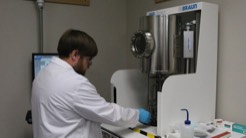 Part of the Materials Fabrication Lab, this PC controlled (both power and temperature
via LabView) stand-alone thermal evaporator is capable of monitoring pressure, power
and thickness. It is capable of co-evaporation or sequential evaporation of metals
or organics. Technical specifications: Sample Holder - up to 4”, rotating at 3 RPM;
dry scroll pump and turbo molecular pump; base Pressure: 2 x 10-6 Torr; sources - dual crucible evaporator with auto shutters, programmable evaporation
route; automatic control of deposition rate and thickness.
Part of the Materials Fabrication Lab, this PC controlled (both power and temperature
via LabView) stand-alone thermal evaporator is capable of monitoring pressure, power
and thickness. It is capable of co-evaporation or sequential evaporation of metals
or organics. Technical specifications: Sample Holder - up to 4”, rotating at 3 RPM;
dry scroll pump and turbo molecular pump; base Pressure: 2 x 10-6 Torr; sources - dual crucible evaporator with auto shutters, programmable evaporation
route; automatic control of deposition rate and thickness.

Spirit® One 1040-8 is a solid-state laser with 8 W output power, 40 μJ max pulse energy at 1040 nm wavelength, 200 kHz repetition rate and <200 fs pulse width.
OPO's are tunable sources of coherent light. An OPO exploits the non-linear behavior of certain crystals when irradiated by an intense light source. When a non-linear crystal is illuminated by an intense pump beam, it will emit two other waves called the idler and signal in a process called three-wave mixing. The Spirit-OPA is an automated collinear optical parametric amplifier (OPA) specifically built and optimized for the Spirit® ultrafast lasers. The Spirit-OPA includes a built-in second harmonic generator to convert the Spirit® IR output into a 520 nm pump beam for the OPA, which then generates signal and idler in the red infrared range (630–2600 nm). To further enhance its wavelength tuning capabilities, the OPA is equipped with harmonic modules that allows access to a broad, gap-free wavelength range from 630 nm up to 16 μm.
 Acquired through NSF MRI grant DMR-1725188 this ORTEC spectrometer is state-of-the-art
picosecond timing system for positron annihilation lifetime spectroscopy (PALS) for
advanced undergraduate research and characterization of the materials’ void structure
at (sub)nanoscale. It is equipped with quick and convenient data acquisition system,
adjustable detectors assembly and warrants time resolution of 200 ps or better.
Acquired through NSF MRI grant DMR-1725188 this ORTEC spectrometer is state-of-the-art
picosecond timing system for positron annihilation lifetime spectroscopy (PALS) for
advanced undergraduate research and characterization of the materials’ void structure
at (sub)nanoscale. It is equipped with quick and convenient data acquisition system,
adjustable detectors assembly and warrants time resolution of 200 ps or better.
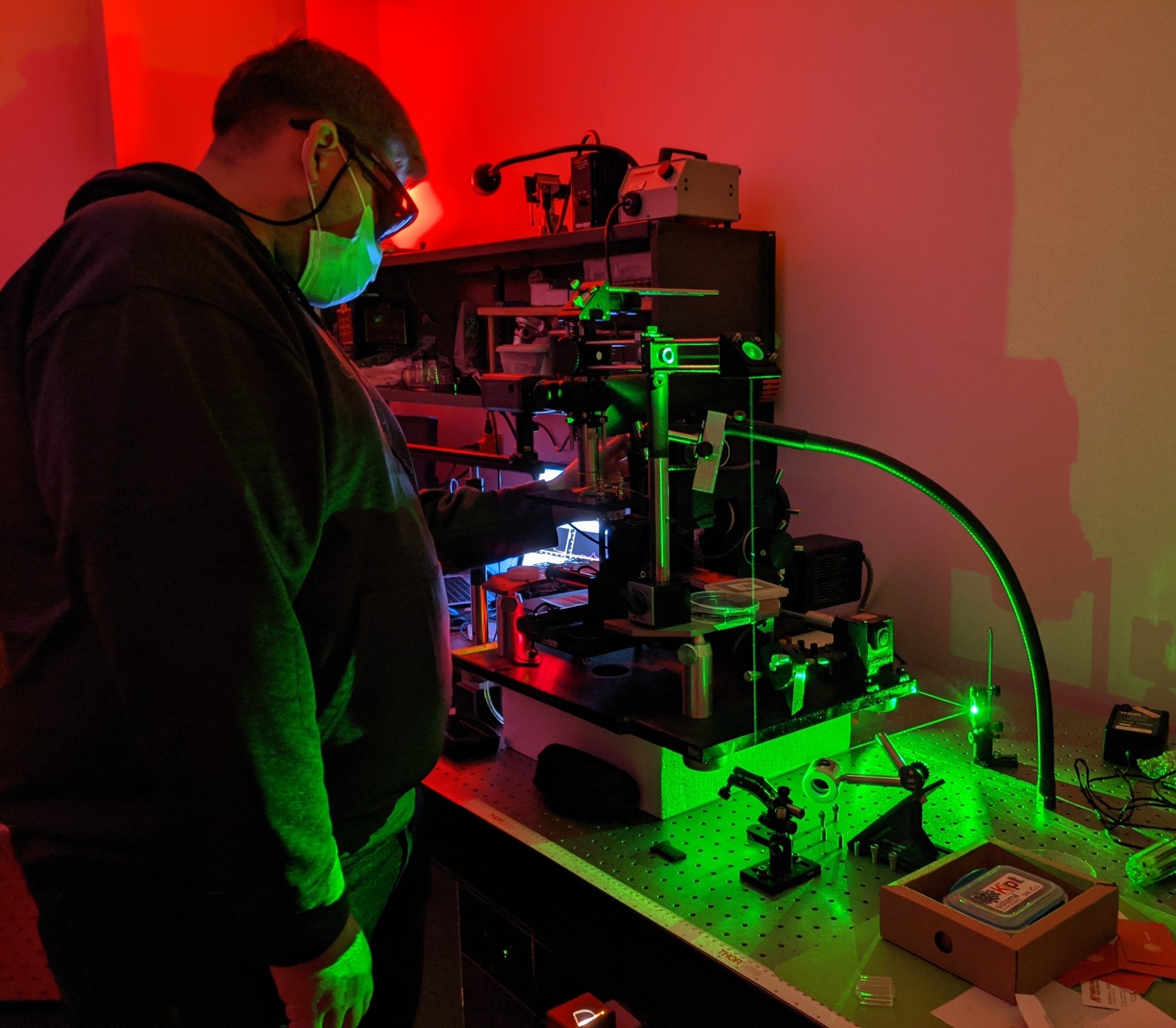 This versatile system is used in research and advanced undergraduate projects for
micro-Raman spectroscopy of bulk solids, powders, liquids, thin films, and microscale
particles (e.g., graphene flakes). It features two swappable laser sources (532 &
633 nm), a fiber-coupled spectrograph (150-mm focal length) with motorized diffraction
gratings (150 & 1800 lines/mm), a high-sensitivity cooled CCD detector (1024x100 pixels),
Köhler and dark-field illumination in reflection, long-working-distance metallurgical
objectives, and XYZ electrostrictive nanopositioners (60-nm resolution) with low hysteresis
and drift. The optical spatial resolution is ~2 microns and the Raman spectral resolution
is ~1.5 cm^-1. Thanks to its highly customizable modular design, the system can accommodate
additional light sources and detectors, a temperature-controlled sample mount, and
optical pathways for reflection and transmission measurements.
This versatile system is used in research and advanced undergraduate projects for
micro-Raman spectroscopy of bulk solids, powders, liquids, thin films, and microscale
particles (e.g., graphene flakes). It features two swappable laser sources (532 &
633 nm), a fiber-coupled spectrograph (150-mm focal length) with motorized diffraction
gratings (150 & 1800 lines/mm), a high-sensitivity cooled CCD detector (1024x100 pixels),
Köhler and dark-field illumination in reflection, long-working-distance metallurgical
objectives, and XYZ electrostrictive nanopositioners (60-nm resolution) with low hysteresis
and drift. The optical spatial resolution is ~2 microns and the Raman spectral resolution
is ~1.5 cm^-1. Thanks to its highly customizable modular design, the system can accommodate
additional light sources and detectors, a temperature-controlled sample mount, and
optical pathways for reflection and transmission measurements.
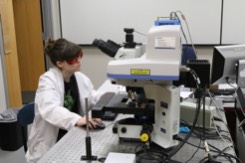 A high performance Raman spectrometer which is coupled to a research grade optical
microscope, allowing both standard optical microscopy and detailed chemical analysis
on a single system. Technical specifications: spatial resolution < 1 micron; spectral
resolution 1.1-1.8 cm-1 depending on the laser source; spectral range 100-4000 cm-1; two excitation lasers (532 and 785nm). Detector – 1024 pixels, high sensitivity
air cooled CCD.
A high performance Raman spectrometer which is coupled to a research grade optical
microscope, allowing both standard optical microscopy and detailed chemical analysis
on a single system. Technical specifications: spatial resolution < 1 micron; spectral
resolution 1.1-1.8 cm-1 depending on the laser source; spectral range 100-4000 cm-1; two excitation lasers (532 and 785nm). Detector – 1024 pixels, high sensitivity
air cooled CCD.
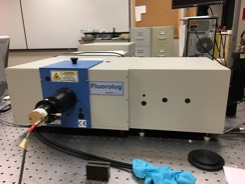 This FL3-11 system has two single-grating spectrometers in the excitation and emission
positions, a T-sample compartment, and a photomultiplier tube (PMT) with a photon
counting system, controlled by a computer. The PMT spectral range is from 250 nm
to 800 nm. The steady-state excitation source is a broadband 450 W Xenon lamp with
emission from the UV to near-IR. With this excitation source, luminescence emission
and excitation spectra from 250 – 800 nm can be measured. This FL3-11 system is also
equipped with a Time-Correlated Single-Photon Counting system (TCSPC), including a
HORIBA FloroHub station and fixed-wavelength interchangeable pulsed NanoLEDs and SpectraLEDs.
Wavelengths of 280, 320, 370, and 390 nm are available from standard optical pulse
durations from 200 ps to 2 ns. Lifetime from 200 ps to 10 μs can be measured using
this TCSPC and lifetime from 10 μ to 10 ms can be measured operating in the MCS mode
using pulsed SpectraLED.
This FL3-11 system has two single-grating spectrometers in the excitation and emission
positions, a T-sample compartment, and a photomultiplier tube (PMT) with a photon
counting system, controlled by a computer. The PMT spectral range is from 250 nm
to 800 nm. The steady-state excitation source is a broadband 450 W Xenon lamp with
emission from the UV to near-IR. With this excitation source, luminescence emission
and excitation spectra from 250 – 800 nm can be measured. This FL3-11 system is also
equipped with a Time-Correlated Single-Photon Counting system (TCSPC), including a
HORIBA FloroHub station and fixed-wavelength interchangeable pulsed NanoLEDs and SpectraLEDs.
Wavelengths of 280, 320, 370, and 390 nm are available from standard optical pulse
durations from 200 ps to 2 ns. Lifetime from 200 ps to 10 μs can be measured using
this TCSPC and lifetime from 10 μ to 10 ms can be measured operating in the MCS mode
using pulsed SpectraLED.
 The NETZSCH DSC-204 F1 determines the temperature and heat flow associated with material
transitions as a function of time and temperature. It also provides quantitative and
qualitative data on endothermic (heat absorption) and exothermic (heat release) processes
of materials during physical transitions that are caused by phase changes, melting,
crystallization, oxidation, and other heat-related changes. The instrument allows
DSC measurements in 30 oC – 700 oC temperature range. This instrument works in conjunction with a controller (computer)
and PROTEUS analysis software to make up a thermal analysis system.
The NETZSCH DSC-204 F1 determines the temperature and heat flow associated with material
transitions as a function of time and temperature. It also provides quantitative and
qualitative data on endothermic (heat absorption) and exothermic (heat release) processes
of materials during physical transitions that are caused by phase changes, melting,
crystallization, oxidation, and other heat-related changes. The instrument allows
DSC measurements in 30 oC – 700 oC temperature range. This instrument works in conjunction with a controller (computer)
and PROTEUS analysis software to make up a thermal analysis system.
The AvaSpec-ULS2048XL-2-USB2 Dual Channel Ultra-low straylight Fiber Optic Spectrometer with 2048XL pixel CCD detector and 300 lines/mm grating allows spectroscopic analysis in the ultraviolet and visible portions of the electromagnetic spectrum. Usable range 200-1100nm, resolution 2.5nm (FWHM). Includes deep UV deuterium-halogen light source, long-life 2000 hrs, 190-2500 nm.